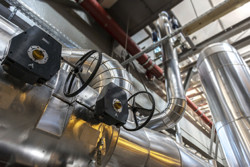Anticipating creep damage in steel
Fossil fuel-fired power plants produce electricity under very harsh working conditions. They have numerous pressurised components such as boiler tubing and steam piping that operate at very high temperatures (around 550 degrees Celsius). Although many of the metal pressure components employ specialised materials to protect them from damage, there is a rising incidence of failures. Parts are failing 25–50 % earlier than predicted at the same time they are supposed to stay in service longer due to plant life extension programmes. As a first step to solving this pressing problem, scientists are conducting a theoretical assessment of ultrasonic sensitivity to creep damage at an early stage. Financial support provided by the EU for the project CREEPTEST(opens in new window) is aiding the effort. Creep is a time-dependent, thermally assisted deformation of a component operating under stress. Type IV creep damage is particularly worrisome. It is currently not clear if damage starts on the surface and propagates inwards or vice versa. Existing NDT methods cannot adequately monitor below the surface. If damage starts internally, by the time it is detected at the surface the remaining life of the component may be dangerously close to its end. The ultrasound transducer design to ensure sensitivity to creep damage at an early stage is key to the project's success. This work is ongoing in parallel with design and fabrication of the other components. Scientists are using specimens with varying amounts of creep damage provided by a partner end user to design system components. Researchers have designed the ultrasonic scanner, but fabrication will commence only once the final transducer design is achieved to ensure compatibility. The pulser-receiver sends a high-voltage pulse to the transducer and conditions the analogue signal when it is received (before digitisation). Both this and the controlling software are under development. CREEPTEST expects to deliver a prototype for field testing. Data collected from both the specimens supplied by partners as well as from the field testing will enable verification of technical capabilities and support future industrial trials for full qualification.







